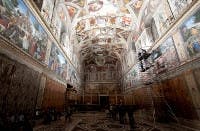Osram LEDs to light the Sistine Chapel's Michelangelo frescoes
Osram's lighting business has announced that it will be retrofitting the lighting in the Rome, Italy Sistine Chapel, using LED-based fixtures to highlight the Michelangelo frescoes. The project, involving custom-designed fixtures optimized for beam control and with a color spectrum that will highlight the pigmentation in the frescoes, will be completed next year, although a pilot project entitled LED4Art has already proven the concept.
While LED-based solid-state lighting (SSL) has long offered efficiency advantages compared to legacy sources, it's a fairly recent development in which LED fixtures have become accepted in museum or historical settings where artwork is omnipresent. "Art presents the most demanding requirements on light," said Peter Laier, Osram CTO. "Following the globally unique lighting solution in the Lenbachhaus Museum in Munich, the world-renowned frescoes in the Sistine Chapel are now being subjected to the same extremely high lighting specifications, once again underlining the authority of Osram as integrated lighting expert operating in accordance with maximum specifications."
In the case of the Sistine Chapel, LED lighting will provide an immediate improvement in terms of the visitor experience. Views of the historic work have been hampered by the fact that the prior lighting was limited to 5–10 lx on the frescoes, combined in the daytime with natural light. Low light levels were in part used to ensure minimal degradation of the paintings, although the cathedral caretakers also wanted to ensure that the artificial light did not contrast with the natural light in terms of direction and focus.
The new lighting will be aimed precisely in the same direction as the natural light with the fixtures hidden below windows. The SSL project will ensure uniform lighting with no glare, although illuminance levels will rise to 50 to 100 lx — a level typical of museum lighting of artwork. That level will provide a much better viewing experience while still minimizing degradation of the work, especially since LEDs don't emit energy in the UV band.
Despite the much higher light levels, Osram said that the new lighting will reduce energy consumption by more than 60%. The savings are due both to the efficiency of LEDs, and to precise beam control that will minimize light spill.
The European Subsidy Program for Information and Communication Technology within the Framework Program on Competitiveness and Innovation (PSP-CIP) subsidized the LED4Art pilot project. Osram is coordinating the project and other participants include the University of Pannonia in Hungary, the Institut de Recerca en Energia de Catalunya in Spain, and the planning offices of Faber Technica in Italy.






